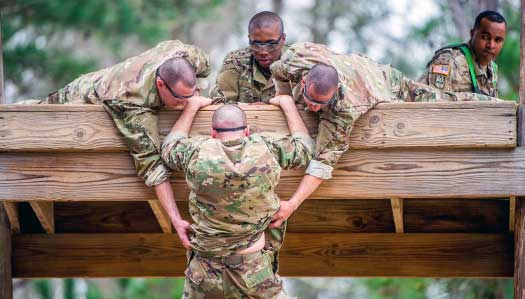 Fabiola Cardozo / NNOMY / español - Some elements make the popularity, frequency, and increased rate of the military enlistment of many young people possible. One of the most important is the influence they receive from their environment on the part of those people who act as counselors and teachers within the schools they attend, as well as from their parents or relatives at home. The normalization of militarization in American society leads us to think of military enlistment as a great option for young people’s futures. However, little is said about the real difficulties they will face. An adult who advises a teenager on military enlistment has naturalized war in a way that is not conducive to better decision-making on the part of young people, preventing the exploration of less violent alternatives. (See: http://peacefulcareers.org/index.html).
Fabiola Cardozo / NNOMY / español - Some elements make the popularity, frequency, and increased rate of the military enlistment of many young people possible. One of the most important is the influence they receive from their environment on the part of those people who act as counselors and teachers within the schools they attend, as well as from their parents or relatives at home. The normalization of militarization in American society leads us to think of military enlistment as a great option for young people’s futures. However, little is said about the real difficulties they will face. An adult who advises a teenager on military enlistment has naturalized war in a way that is not conducive to better decision-making on the part of young people, preventing the exploration of less violent alternatives. (See: http://peacefulcareers.org/index.html).
Within the school, some teachers and counselors receive encouragement from the Pentagon to influence and foster an interest in the military sector in young people. As we know, between students and teachers or counselors, there is an inherent power dynamic that gives educators almost unquestionable validity, leading to a dangerous influence. Likewise, the constant visits of military recruiters and the implementation of school programs that encourage entry into military service mean that young people are being permanently influenced by this idea. (See: https://nnomy.org/en/what-is-militarization/school-militarization.html).
Military cadet programs at schools like JROTC and Young Marines are always promoted as leadership programs. But is it a youth leadership program, or is it more of a strategy that is part of a grand plan to keep the war machine running where young people are the most vulnerable? Who is really in charge of these programs? Are young people able to decide autonomously? It is convenient to think about the influence that all these programs exert to promote military enlistment, coupled with a militaristic culture that is fostered within all the spaces in which young people live. Video games, movies, programs, TV series, and even music offer a glorified image of military life that is not exactly a true reflection of reality, making it possible for violent behavior to increase in children and young people.
While there are multiple factors that lead to violent actions, a growing body of literature shows a strong association between the perpetration of violence and the exposure to violence through the media. Studies demonstrating an association between exposure to violence in the media and real-life aggression and violence began appearing in the 1950s. Since then, various government agencies and organizations have examined the relationship. (See: https://www.aafp.org/about/policies/all/violence-media-entertainment.html).
We must also consider the few opportunities that are offered to the poorest and most marginalized communities, these being the target audience of military enlistment, where it is sold as an option or "the best option" to socially advance their lives. At times, counselors and professors advise young men to join the military if they lack the “good” grades necessary to qualify for scholarships that allow them to enter university, without giving them more information about other options.
The term “poverty draft” came about in the early 1980s to describe “the belief that the enlisted ranks of the military were made up of young people with limited economic opportunities,” Sojourners reports. Rocio Cordova, program coordinator for the Project on Youth and Non-military Opportunities, describes this phenomenon as a “draft-like system that pushes non-privileged people into enlisting because they lack access to jobs, income, and educational alternatives in their communities.” (See: https://www.teenvogue.com/story/the-military-targets-youth-for-recruitment).
With the promise of leaving poverty and all that it entails behind, many young people enter the military service. However, all the difficulties that arise—discrimination, bullying, and different expressions of violence—can trigger serious problems such as depression, anxiety, and low self-esteem, among others.
Although adults in the active military service are reported to experience increased mental health risks, including stress, substance abuse, and suicide, there is evidence that military service for the youngest soldiers is consistently associated with health effects far worse than for those who are older. This suggests that military service is associated with disproportionately poor health for those in late adolescence. These negative outcomes for teen soldiers, coupled with significant evidence that the adolescent brain is not equipped to make accurate risk calculations, leads APHA to conclude entry into the military should be delayed until full adulthood. For these reasons, the American Public Health Association opposes military recruiting in public elementary and secondary schools. (See: https://www.apha.org/policies-and-advocacy/public-health-policy-statements/policy-database/2014/07/23/11/19/cessation-of-military-recruiting-in-public-elementary-and-secondary-schools).
When thinking about military recruitment, it is necessary to reflect on and question the social influence that is exerted on young people. We must also offer more information about other possibilities for their professional and personal development, as well as create a culture that is strongly and actively critical of the militarization of American society.
###